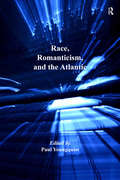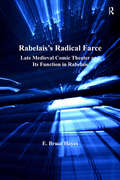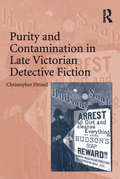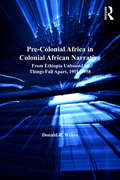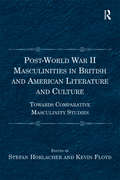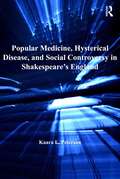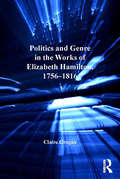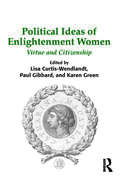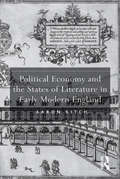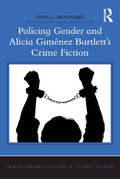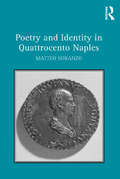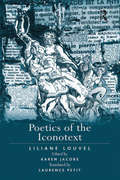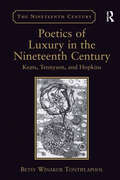- Table View
- List View
Race, Romanticism, and the Atlantic
by Paul YoungquistIn highlighting the crucial contributions of diasporic people to British cultural production, this important collection defamiliarizes prevailing descriptions of Romanticism as the expression of a national character or culture. The contributors approach the period from the perspective of the Atlantic maritime economy, making a strong case for viewing British Romanticism as the effect of myriad economic and cultural exchanges occurring throughout a circum-Atlantic world driven by an insatiable hunger for sugar and slaves. Typically taken for granted, the material contributions of slaves, sailors, and servants shaped Romanticism both in spite of and because of the severe conditions they experienced throughout the Atlantic world. The essays range from Sierra Leone to Jamaica to Nova Scotia to the metropole, examining not only the desperate circumstances of diasporic peoples but also the extraordinary force of their creativity and resistance. Of particular importance is the emergence of race as a category of identity, class, and containment. Race, Romanticism, and the Atlantic explores that process both economically and theoretically, showing how race ensures the persistence of servitude after abolition. At the same time, the collection never loses sight of the extraordinary contributions diasporic peoples made to British culture during the Romantic era.
Rabelais's Radical Farce: Late Medieval Comic Theater and Its Function in Rabelais
by E. Bruce HayesIn the first extended investigation of the importance of dramatic farce in Rabelais studies, Bruce Hayes makes an important contribution to the understanding of the theater of farce and its literary possibilities. By tracing the development of farce in late medieval and Renaissance comedic theater in comparison to the evolution of farce in Rabelais's work, Hayes distinguishes Rabelais's use of the device from traditional farce. While traditional farce is primarily conservative in its aims, with an emphasis on maintaining the status quo, Rabelais puts farce to radical new uses, making it subversive in his own work. Bruce Hayes examines the use of farce in Pantagruel, Gargantua, and the Tiers and Quart livres, showing how Rabelais recast farce in a humanist context, making it a vehicle for attacking the status quo and posing alternatives to contemporary legal, educational, and theological systems. Rabelais's Radical Farce illustrates the rich possibilities of a genre often considered simplistic and unsophisticated, disclosing how Rabelais in fact introduced both a radical reformulation of farce, and a new form of humanist satire.
Rabelais's Radical Farce: Late Medieval Comic Theater and Its Function in Rabelais
by E. Bruce HayesIn the first extended investigation of the importance of dramatic farce in Rabelais studies, Bruce Hayes makes an important contribution to the understanding of the theater of farce and its literary possibilities. By tracing the development of farce in late medieval and Renaissance comedic theater in comparison to the evolution of farce in Rabelais's work, Hayes distinguishes Rabelais's use of the device from traditional farce. While traditional farce is primarily conservative in its aims, with an emphasis on maintaining the status quo, Rabelais puts farce to radical new uses, making it subversive in his own work. Bruce Hayes examines the use of farce in Pantagruel, Gargantua, and the Tiers and Quart livres, showing how Rabelais recast farce in a humanist context, making it a vehicle for attacking the status quo and posing alternatives to contemporary legal, educational, and theological systems. Rabelais's Radical Farce illustrates the rich possibilities of a genre often considered simplistic and unsophisticated, disclosing how Rabelais in fact introduced both a radical reformulation of farce, and a new form of humanist satire.
Purity and Contamination in Late Victorian Detective Fiction
by Christopher PittardConcentrating on works by authors such as Fergus Hume, Arthur Conan Doyle, Grant Allen, L.T. Meade, and Marie Belloc Lowndes, Christopher Pittard explores the complex relation between the emergence of detective fictions in the 1880s and 1890s and the concept of purity. The centrality of material and moral purity as a theme of the genre, Pittard argues, both reflected and satirised a contemporary discourse of degeneration in which criminality was equated with dirt and disease and where national boundaries were guarded against the threat of the criminal foreigner. Situating his discussion within the ideologies underpinning George Newnes's Strand Magazine as well as a wide range of nonfiction texts, Pittard demonstrates that the genre was a response to the seductive and impure delights associated with sensation and gothic novels. Further, Pittard suggests that criticism of detective fiction has in turn become obsessed with the idea of purity, thus illustrating how a genre concerned with policing the impure itself became subject to the same fear of contamination. Contributing to the richness of Pittard's project are his discussions of the convergence of medical discourse and detective fiction in the 1890s, including the way social protest movements like the antivivisectionist campaigns and medical explorations of criminality raised questions related to moral purity.
Purity and Contamination in Late Victorian Detective Fiction
by Christopher PittardConcentrating on works by authors such as Fergus Hume, Arthur Conan Doyle, Grant Allen, L.T. Meade, and Marie Belloc Lowndes, Christopher Pittard explores the complex relation between the emergence of detective fictions in the 1880s and 1890s and the concept of purity. The centrality of material and moral purity as a theme of the genre, Pittard argues, both reflected and satirised a contemporary discourse of degeneration in which criminality was equated with dirt and disease and where national boundaries were guarded against the threat of the criminal foreigner. Situating his discussion within the ideologies underpinning George Newnes's Strand Magazine as well as a wide range of nonfiction texts, Pittard demonstrates that the genre was a response to the seductive and impure delights associated with sensation and gothic novels. Further, Pittard suggests that criticism of detective fiction has in turn become obsessed with the idea of purity, thus illustrating how a genre concerned with policing the impure itself became subject to the same fear of contamination. Contributing to the richness of Pittard's project are his discussions of the convergence of medical discourse and detective fiction in the 1890s, including the way social protest movements like the antivivisectionist campaigns and medical explorations of criminality raised questions related to moral purity.
Pre-Colonial Africa in Colonial African Narratives: From Ethiopia Unbound to Things Fall Apart, 1911–1958
by Donald R. WehrsIn his study of the origins of political reflection in twentieth-century African fiction, Donald Wehrs examines a neglected but important body of African texts written in colonial (English and French) and indigenous (Hausa and Yoruba) languages. He explores pioneering narrative representations of pre-colonial African history and society in seven texts: Casely Hayford's Ethiopia Unbound (1911), Alhaji Sir Abubaker Tafawa Balewa's Shaihu Umar (1934), Paul Hazoumé's Doguicimi (1938), D.O. Fagunwa's Forest of a Thousand Daemons (1938), Amos Tutuola's The Palm-Wine Drinkard (1952) and My Life in the Bush of Ghosts (1954), and Chinua Achebe's Things Fall Apart (1958). Wehrs highlights the role of pre-colonial political economies and articulations of state power on colonial-era considerations of ethical and political issues, and is attentive to the gendered implications of texts and authorial choices. By positioning Things Fall Apart as the culmination of a tradition, rather than as its inaugural work, he also reconfigures how we think of African fiction. His book supplements recent work on the importance of indigenous contexts and discourses in situating colonial-era narratives and will inspire fresh methodological strategies for studying the continent from a multiplicity of perspectives.
Pre-Colonial Africa in Colonial African Narratives: From Ethiopia Unbound to Things Fall Apart, 1911–1958
by Donald R. WehrsIn his study of the origins of political reflection in twentieth-century African fiction, Donald Wehrs examines a neglected but important body of African texts written in colonial (English and French) and indigenous (Hausa and Yoruba) languages. He explores pioneering narrative representations of pre-colonial African history and society in seven texts: Casely Hayford's Ethiopia Unbound (1911), Alhaji Sir Abubaker Tafawa Balewa's Shaihu Umar (1934), Paul Hazoumé's Doguicimi (1938), D.O. Fagunwa's Forest of a Thousand Daemons (1938), Amos Tutuola's The Palm-Wine Drinkard (1952) and My Life in the Bush of Ghosts (1954), and Chinua Achebe's Things Fall Apart (1958). Wehrs highlights the role of pre-colonial political economies and articulations of state power on colonial-era considerations of ethical and political issues, and is attentive to the gendered implications of texts and authorial choices. By positioning Things Fall Apart as the culmination of a tradition, rather than as its inaugural work, he also reconfigures how we think of African fiction. His book supplements recent work on the importance of indigenous contexts and discourses in situating colonial-era narratives and will inspire fresh methodological strategies for studying the continent from a multiplicity of perspectives.
Post-World War II Masculinities in British and American Literature and Culture: Towards Comparative Masculinity Studies
by Stefan Horlacher Kevin FloydAnalyzing literary texts, plays, films and photographs within a transatlantic framework, this volume explores the inseparable and mutually influential relationship between different forms of national identity in Great Britain and the United States and the construction of masculinity in each country. The contributors take up issues related to how certain kinds of nationally specific masculine identifications are produced, how these change over time, and how literature and other forms of cultural representation eventually question and deconstruct their own myths of masculinity. Focusing on the period from the end of World War II to the 1980s, the essays each take up a topic with particular cultural and historical resonance, whether it is hypermasculinity in early cold war films; the articulation of male anxieties in plays by Arthur Miller, David Mamet and Sam Shepard; the evolution of photographic depictions of masculinity from the 1960s to the 1980s; or the representations of masculinity in the fiction of American and British writers such as Patricia Highsmith, Richard Yates, John Braine, Martin Amis, Evan S. Connell, James Dickey, John Berger, Philip Roth, Frank Chin, and Maxine Hong Kingston. The editors and contributors make a case for the importance of understanding the larger context for the emergence of more pluralistic, culturally differentiated and ultimately transnational masculinities, arguing that it is possible to conceptualize and emphasize difference and commonality simultaneously.
Post-World War II Masculinities in British and American Literature and Culture: Towards Comparative Masculinity Studies
by Stefan Horlacher Kevin FloydAnalyzing literary texts, plays, films and photographs within a transatlantic framework, this volume explores the inseparable and mutually influential relationship between different forms of national identity in Great Britain and the United States and the construction of masculinity in each country. The contributors take up issues related to how certain kinds of nationally specific masculine identifications are produced, how these change over time, and how literature and other forms of cultural representation eventually question and deconstruct their own myths of masculinity. Focusing on the period from the end of World War II to the 1980s, the essays each take up a topic with particular cultural and historical resonance, whether it is hypermasculinity in early cold war films; the articulation of male anxieties in plays by Arthur Miller, David Mamet and Sam Shepard; the evolution of photographic depictions of masculinity from the 1960s to the 1980s; or the representations of masculinity in the fiction of American and British writers such as Patricia Highsmith, Richard Yates, John Braine, Martin Amis, Evan S. Connell, James Dickey, John Berger, Philip Roth, Frank Chin, and Maxine Hong Kingston. The editors and contributors make a case for the importance of understanding the larger context for the emergence of more pluralistic, culturally differentiated and ultimately transnational masculinities, arguing that it is possible to conceptualize and emphasize difference and commonality simultaneously.
Popular Medicine, Hysterical Disease, and Social Controversy in Shakespeare's England
by Kaara L. PetersonMining a series of previously uncharted conversations springing up in 16th- and 17th-century popular medicine and culture, this study explores early modern England's significant and sustained interest in the hysterical diseases of women. Kaara L. Peterson assembles a fascinating collection of medical materials to support her discussion of contemporary debates about varieties of uterine pathologies and the implications of these debates for our understanding of drama's representation of hysterica passio cases in particular, among other hysterical maladies. An important aspect of the author's approach is to restore, with all its nuances, the debates created by early modern medical writers over attempts to define the boundaries and resonances of hysterical ailments, which Peterson argues have been largely erased or elided by historicist criticism, including scholarship overly focused on melancholy. One of the main goals of the book is to stress the centrality of gendered concepts of disease for the period and to reveal a whole catalog of early modern literary strategies for representing women's illnesses. Among the medical works discussed are Edward Jorden's central text A Briefe Discourse of a Disease Called the Suffocation of the Mother (1603) and contemporary plays, including Shakespeare's Pericles, Othello, King Lear, and The Winter's Tale; Webster's The Duchess of Malfi; and Chapman's Bussy D'Ambois.
Popular Medicine, Hysterical Disease, and Social Controversy in Shakespeare's England
by Kaara L. PetersonMining a series of previously uncharted conversations springing up in 16th- and 17th-century popular medicine and culture, this study explores early modern England's significant and sustained interest in the hysterical diseases of women. Kaara L. Peterson assembles a fascinating collection of medical materials to support her discussion of contemporary debates about varieties of uterine pathologies and the implications of these debates for our understanding of drama's representation of hysterica passio cases in particular, among other hysterical maladies. An important aspect of the author's approach is to restore, with all its nuances, the debates created by early modern medical writers over attempts to define the boundaries and resonances of hysterical ailments, which Peterson argues have been largely erased or elided by historicist criticism, including scholarship overly focused on melancholy. One of the main goals of the book is to stress the centrality of gendered concepts of disease for the period and to reveal a whole catalog of early modern literary strategies for representing women's illnesses. Among the medical works discussed are Edward Jorden's central text A Briefe Discourse of a Disease Called the Suffocation of the Mother (1603) and contemporary plays, including Shakespeare's Pericles, Othello, King Lear, and The Winter's Tale; Webster's The Duchess of Malfi; and Chapman's Bussy D'Ambois.
Politics and Genre in the Works of Elizabeth Hamilton, 1756–1816
by Claire GroganIn the first book-length study of the well-respected and popular British writer Elizabeth Hamilton, Claire Grogan addresses a significant gap in scholarship that enlarges and complicates critical understanding of the Romantic woman writer. From 1797 to 1818, Hamilton published in a wide range of genres, including novels, satires, historical and educational treatises, and historical biography. Because she wrote from a politically centrist position during a revolutionary age, Grogan suggests, Hamilton has been neglected in favor of authors who fit within the Jacobin/anti-Jacobin framework used to situate women writers of the period. Grogan draws attention to the inadequacies of the Jacobin/anti-Jacobin binary for understanding writers like Hamilton, arguing that Hamilton and other women writers engaged with and debated the issues of the day in more veiled ways. For example, while Hamilton did not argue for sexual emancipation à la Mary Wollstonecraft and Mary Hays, she asserted her rights in other ways. Hamilton's most radical advance, Grogan shows, was in her deployment of genre, whether she was mixing genres, creating new generic medleys, or assuming competence in a hitherto male-dominated genre. With Hamilton serving as her case study, Grogan persuasively argues for new strategies to uncover the means by which women writers participated in the revolutionary debate.
Politics and Genre in the Works of Elizabeth Hamilton, 1756–1816
by Claire GroganIn the first book-length study of the well-respected and popular British writer Elizabeth Hamilton, Claire Grogan addresses a significant gap in scholarship that enlarges and complicates critical understanding of the Romantic woman writer. From 1797 to 1818, Hamilton published in a wide range of genres, including novels, satires, historical and educational treatises, and historical biography. Because she wrote from a politically centrist position during a revolutionary age, Grogan suggests, Hamilton has been neglected in favor of authors who fit within the Jacobin/anti-Jacobin framework used to situate women writers of the period. Grogan draws attention to the inadequacies of the Jacobin/anti-Jacobin binary for understanding writers like Hamilton, arguing that Hamilton and other women writers engaged with and debated the issues of the day in more veiled ways. For example, while Hamilton did not argue for sexual emancipation à la Mary Wollstonecraft and Mary Hays, she asserted her rights in other ways. Hamilton's most radical advance, Grogan shows, was in her deployment of genre, whether she was mixing genres, creating new generic medleys, or assuming competence in a hitherto male-dominated genre. With Hamilton serving as her case study, Grogan persuasively argues for new strategies to uncover the means by which women writers participated in the revolutionary debate.
Political Ideas of Enlightenment Women: Virtue and Citizenship
by Lisa Curtis-Wendlandt Paul Gibbard Karen GreenThis edited collection showcases the contribution of women to the development of political ideas during the Enlightenment, and presents an alternative to the male-authored canon of philosophy and political thought. Over the course of the eighteenth century increasing numbers of women went into print, and they exploited both new and traditional forms to convey their political ideas: from plays, poems, and novels to essays, journalism, annotated translations, and household manuals, as well as dedicated political tracts. Recently, considerable scholarly attention has been paid to women’s literary writing and their role in salon society, but their participation in political debates is less well studied. This volume offers new perspectives on some better known authors such as Mary Wollstonecraft, Catharine Macaulay, and Anna Laetitia Barbauld, as well as neglected figures from the British Isles and continental Europe. The collection advances discussion of how best to understand women’s political contributions during the period, the place of salon sociability in the political development of Europe, and the interaction between discourses on slavery and those on women’s rights. It will interest scholars and researchers working in women’s intellectual history and Enlightenment thought and serve as a useful adjunct to courses in political theory, women’s studies, the history of feminism, and European history.
Political Ideas of Enlightenment Women: Virtue and Citizenship
by Lisa Curtis-Wendlandt Paul Gibbard Karen GreenThis edited collection showcases the contribution of women to the development of political ideas during the Enlightenment, and presents an alternative to the male-authored canon of philosophy and political thought. Over the course of the eighteenth century increasing numbers of women went into print, and they exploited both new and traditional forms to convey their political ideas: from plays, poems, and novels to essays, journalism, annotated translations, and household manuals, as well as dedicated political tracts. Recently, considerable scholarly attention has been paid to women’s literary writing and their role in salon society, but their participation in political debates is less well studied. This volume offers new perspectives on some better known authors such as Mary Wollstonecraft, Catharine Macaulay, and Anna Laetitia Barbauld, as well as neglected figures from the British Isles and continental Europe. The collection advances discussion of how best to understand women’s political contributions during the period, the place of salon sociability in the political development of Europe, and the interaction between discourses on slavery and those on women’s rights. It will interest scholars and researchers working in women’s intellectual history and Enlightenment thought and serve as a useful adjunct to courses in political theory, women’s studies, the history of feminism, and European history.
Political Economy and the States of Literature in Early Modern England
by Aaron KitchCrossing the disciplinary borders between political, religious, and economic history, Aaron Kitch's innovative new study demonstrates how sixteenth-century treatises and debates about trade influenced early modern English literature by shaping key formal and aesthetic concerns of authors between 1580 and 1630. The author's analysis concentrates on a commonly overlooked period of economic history-the English commercial revolution before 1620-and, utilizing an impressive combination of archival research, close reading, and attention to historical detail, traces the transformation of genre in both neglected and canonical texts. The topics here are wide-ranging but are presented with a commitment to providing a concrete understanding of the religious, political, and historic context in literary thought. Kitch begins with the emerging wool trade and explosion of economic writing, Spenser's glorification of commerce and the Protestant state as presented in The Faerie Queene, and writers such as Thomas Nashe who drew on the same economic principles to challenge Spenser. Other topics include the reaction to the herring trade in prose satire and pamphlets, the presentation of Jewish trading nations in Shakespeare and Marlowe, and the tension between the crown and London merchants as reflected in Middleton's city comedies and Jonson's and Munday's pageants and court masques.
Political Economy and the States of Literature in Early Modern England
by Aaron KitchCrossing the disciplinary borders between political, religious, and economic history, Aaron Kitch's innovative new study demonstrates how sixteenth-century treatises and debates about trade influenced early modern English literature by shaping key formal and aesthetic concerns of authors between 1580 and 1630. The author's analysis concentrates on a commonly overlooked period of economic history-the English commercial revolution before 1620-and, utilizing an impressive combination of archival research, close reading, and attention to historical detail, traces the transformation of genre in both neglected and canonical texts. The topics here are wide-ranging but are presented with a commitment to providing a concrete understanding of the religious, political, and historic context in literary thought. Kitch begins with the emerging wool trade and explosion of economic writing, Spenser's glorification of commerce and the Protestant state as presented in The Faerie Queene, and writers such as Thomas Nashe who drew on the same economic principles to challenge Spenser. Other topics include the reaction to the herring trade in prose satire and pamphlets, the presentation of Jewish trading nations in Shakespeare and Marlowe, and the tension between the crown and London merchants as reflected in Middleton's city comedies and Jonson's and Munday's pageants and court masques.
Policing Gender and Alicia Giménez Bartlett's Crime Fiction (New Hispanisms: Cultural and Literary Studies)
by Nina L. MolinaroAlicia Giménez Bartlett’s popular crime series, written in Spanish and organized around the exploits of Police Inspector Petra Delicado and Deputy Inspector Fermin Garzon, is arguably the most successful detective series published in Spain during the previous three decades. Nina L. Molinaro examines the tensions between the rhetoric of gender differences espoused by the woman detective and the orthodox ideology of the police procedural. She argues that even as the series incorporates gender differences into the crime series formula, it does so in order to correct women, naturalize men’s authority, sanction social hierarchies, and assuage collective anxieties. As Molinaro shows, with the exception of the protagonist, the women characters require constant surveillance and modification, often as a result of men’s supposedly intrinsic protectiveness or excessive sexuality. Men, by contrast, circulate more freely in the fictional world and are intrinsic to the political, psychological, and economic prosperity of their communities. Molinaro situates her discussion in Petra Delicado’s contemporary Spain of dog owners, ¡Hola!, Russian cults, and gated communities.
Policing Gender and Alicia Giménez Bartlett's Crime Fiction (New Hispanisms: Cultural and Literary Studies)
by Nina L. MolinaroAlicia Giménez Bartlett’s popular crime series, written in Spanish and organized around the exploits of Police Inspector Petra Delicado and Deputy Inspector Fermin Garzon, is arguably the most successful detective series published in Spain during the previous three decades. Nina L. Molinaro examines the tensions between the rhetoric of gender differences espoused by the woman detective and the orthodox ideology of the police procedural. She argues that even as the series incorporates gender differences into the crime series formula, it does so in order to correct women, naturalize men’s authority, sanction social hierarchies, and assuage collective anxieties. As Molinaro shows, with the exception of the protagonist, the women characters require constant surveillance and modification, often as a result of men’s supposedly intrinsic protectiveness or excessive sexuality. Men, by contrast, circulate more freely in the fictional world and are intrinsic to the political, psychological, and economic prosperity of their communities. Molinaro situates her discussion in Petra Delicado’s contemporary Spain of dog owners, ¡Hola!, Russian cults, and gated communities.
Poetry and Identity in Quattrocento Naples
by Matteo SoranzoPoetry and Identity in Quattrocento Naples approaches poems as acts of cultural identity and investigates how a group of authors used poetry to develop a poetic style, while also displaying their position toward the culture of others. Starting from an analysis of Giovanni Pontano’s Parthenopeus and De amore coniugali, followed by a discussion of Jacopo Sannazaro’s Arcadia, Matteo Soranzo links the genesis and themes of these texts to the social, political and intellectual vicissitudes of Naples under the domination of Kings Alfonso and Ferrante. Delving further into Pontano’s literary and astrological production, Soranzo illustrates the consolidation and eventual dispersion of this author’s legacy by looking at the symbolic value attached to his masterpiece Urania, and at the genesis of Sannazaro’s De partu Virginis. Poetic works written in neo-Latin and the vernacular during the Aragonese domination, in this way, are examined not only as literary texts, but also as the building blocks of their authors’ careers.
Poetry and Identity in Quattrocento Naples
by Matteo SoranzoPoetry and Identity in Quattrocento Naples approaches poems as acts of cultural identity and investigates how a group of authors used poetry to develop a poetic style, while also displaying their position toward the culture of others. Starting from an analysis of Giovanni Pontano’s Parthenopeus and De amore coniugali, followed by a discussion of Jacopo Sannazaro’s Arcadia, Matteo Soranzo links the genesis and themes of these texts to the social, political and intellectual vicissitudes of Naples under the domination of Kings Alfonso and Ferrante. Delving further into Pontano’s literary and astrological production, Soranzo illustrates the consolidation and eventual dispersion of this author’s legacy by looking at the symbolic value attached to his masterpiece Urania, and at the genesis of Sannazaro’s De partu Virginis. Poetic works written in neo-Latin and the vernacular during the Aragonese domination, in this way, are examined not only as literary texts, but also as the building blocks of their authors’ careers.
Poetics of the Iconotext
by Liliane Louvel edited by JacobsPoetics of the Iconotext makes available for the first time in English the theories of the respected French text/image specialist, Professor Liliane Louvel. A consolidation of the most significant theoretical materials of Louvel's two acclaimed books, L'Oeil du Texte: Texte et image dans la littérature anglophone and Texte/Image: Images à lire, textes à voir, this newly conceived work introduces English readers to the most current thinking in French text/image theory and visual studies. Focusing on the full spectrum of text/image relations, from medieval illuminated manuscripts to digital books, Louvel begins by introducing key terms and situating her work in the context of significant debates in text/image studies. Part II introduces Louvel's s typology of pictorial saturation through which she establishes a continuum along which to measure the effect of the most figurative to the most literal images upon writerly and readerly textual 'spaces.' Part III adopts a phenomenological approach towards the reading-viewing experience as expressed in conceptual categories that include the trace, focal range, synesthesia, and rhythm and speed. The result is a provocative interplay of the categorical and the subjective that invites readers to think at once more precisely and more inventively about texts, images, and the intersections between the two.
Poetics of the Iconotext
by Liliane Louvel edited by JacobsPoetics of the Iconotext makes available for the first time in English the theories of the respected French text/image specialist, Professor Liliane Louvel. A consolidation of the most significant theoretical materials of Louvel's two acclaimed books, L'Oeil du Texte: Texte et image dans la littérature anglophone and Texte/Image: Images à lire, textes à voir, this newly conceived work introduces English readers to the most current thinking in French text/image theory and visual studies. Focusing on the full spectrum of text/image relations, from medieval illuminated manuscripts to digital books, Louvel begins by introducing key terms and situating her work in the context of significant debates in text/image studies. Part II introduces Louvel's s typology of pictorial saturation through which she establishes a continuum along which to measure the effect of the most figurative to the most literal images upon writerly and readerly textual 'spaces.' Part III adopts a phenomenological approach towards the reading-viewing experience as expressed in conceptual categories that include the trace, focal range, synesthesia, and rhythm and speed. The result is a provocative interplay of the categorical and the subjective that invites readers to think at once more precisely and more inventively about texts, images, and the intersections between the two.
Poetics of Luxury in the Nineteenth Century: Keats, Tennyson, and Hopkins
by Betsy Winakur TontiplapholBeginning with John Keats and tracing a line of influence through Alfred Lord Tennyson and Gerard Manley Hopkins, Betsy Tontiplaphol draws on established narratives of the nineteenth century's social and literary developments to describe the relationship between poetics and luxury in an age when imperial trade and domestic consumerism reached a fevered pitch. The "luscious poem," as Tontiplaphol defines it, is a subset of the luxurious, a category that suggests richness in combination with enclosure and intimacy. For Keats, Tontiplaphol suggests, the psychological virtues of luscious experience generated a new poetics, one that combined his Romantic predecessors' sense of the ameliorative power of poetry with his own revaluation of space, both physical and prosodic. Her approach blends cultural context with close attention to the formal and affective qualities of poetry as she describes the efforts of Keats and his equally”though differently”anxious Victorian inheritors to develop textual spaces as luscious as the ones their language describes. For all three poets, that effort entailed rediscovering and reinterpreting the list, or catalogue, and each chapter's textual and formal analyses are offered in counterpoint to careful examination of the century's luscious materialities. Her book is at once a study of influence, a socio-historical critique, and a form-focused assessment of three century-defining voices.
Poetics of Luxury in the Nineteenth Century: Keats, Tennyson, and Hopkins
by Betsy Winakur TontiplapholBeginning with John Keats and tracing a line of influence through Alfred Lord Tennyson and Gerard Manley Hopkins, Betsy Tontiplaphol draws on established narratives of the nineteenth century's social and literary developments to describe the relationship between poetics and luxury in an age when imperial trade and domestic consumerism reached a fevered pitch. The "luscious poem," as Tontiplaphol defines it, is a subset of the luxurious, a category that suggests richness in combination with enclosure and intimacy. For Keats, Tontiplaphol suggests, the psychological virtues of luscious experience generated a new poetics, one that combined his Romantic predecessors' sense of the ameliorative power of poetry with his own revaluation of space, both physical and prosodic. Her approach blends cultural context with close attention to the formal and affective qualities of poetry as she describes the efforts of Keats and his equally”though differently”anxious Victorian inheritors to develop textual spaces as luscious as the ones their language describes. For all three poets, that effort entailed rediscovering and reinterpreting the list, or catalogue, and each chapter's textual and formal analyses are offered in counterpoint to careful examination of the century's luscious materialities. Her book is at once a study of influence, a socio-historical critique, and a form-focused assessment of three century-defining voices.
